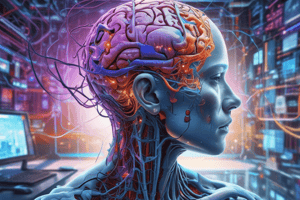Podcast
Questions and Answers
Which of the following methods is NOT commonly used for signal acquisition in BCIs?
Which of the following methods is NOT commonly used for signal acquisition in BCIs?
- EEG
- fMRI
- MRI (correct)
- ECoG
Preprocessing is essential for enhancing the quality of neural signals.
Preprocessing is essential for enhancing the quality of neural signals.
True (A)
What is the primary application of neurotechnology in medical uses?
What is the primary application of neurotechnology in medical uses?
Assistive devices for individuals with disabilities
The technique used to reduce the number of features in signal processing while maintaining essential information is called ______.
The technique used to reduce the number of features in signal processing while maintaining essential information is called ______.
Match the following BCI techniques with their descriptions:
Match the following BCI techniques with their descriptions:
What is a common challenge faced by machine learning algorithms in BCIs?
What is a common challenge faced by machine learning algorithms in BCIs?
Cognitive enhancement tools are part of neurotechnology applications.
Cognitive enhancement tools are part of neurotechnology applications.
Name a method used for filtering noise from brain signals during preprocessing.
Name a method used for filtering noise from brain signals during preprocessing.
Neuroprosthetics are devices used to restore ______.
Neuroprosthetics are devices used to restore ______.
Which type of machine learning is described as discovering patterns in unlabeled data?
Which type of machine learning is described as discovering patterns in unlabeled data?
Study Notes
Brain-Computer Interface (BCI)
Signal Processing
- Definition: The techniques used to extract meaningful information from neural signals for BCI applications.
- Key Steps:
- Signal Acquisition: Collecting brain signals using methods such as EEG, ECoG, or fMRI.
- Preprocessing: Filtering out noise and artifacts to enhance signal quality.
- Feature Extraction: Identifying relevant features from processed signals that correlate with user intent (e.g., frequency bands, signal amplitude).
- Dimensionality Reduction: Techniques like PCA or ICA to reduce the number of features while preserving essential information.
Neurotechnology
- Definition: Technologies that interface with the nervous system, particularly the brain, to monitor, modulate, or enhance neural activity.
- Applications:
- Medical Uses: Assistive devices for individuals with disabilities, neuroprosthetics for restoring movement, and rehabilitation tools.
- Cognitive Enhancement: Tools aimed at improving cognitive functions or mood.
- Ethical Considerations: Issues related to privacy, consent, and the implications of mind-reading and cognitive manipulation.
Machine Learning in BCIs
- Role: Applying machine learning algorithms to improve the performance and adaptability of BCIs.
- Key Techniques:
- Supervised Learning: Training models on labeled datasets to predict user intent based on brain signals.
- Unsupervised Learning: Discovering patterns in unlabeled data, useful for clustering and feature extraction.
- Reinforcement Learning: Adapting models based on feedback from the environment to enhance user experience and control.
- Challenges:
- Data Variety: Variability in neural signals across individuals and sessions.
- Real-Time Processing: Need for algorithms to operate with low latency to ensure responsiveness.
- Overfitting: Risks of models becoming too specialized on training data, affecting generalization to new inputs.
Brain-Computer Interface (BCI)
Signal Processing
- Signal processing extracts meaningful information from neural signals for BCI applications, enhancing interaction between the brain and machines.
- Signal acquisition methods include EEG (Electroencephalography), ECoG (Electrocorticography), and fMRI (Functional Magnetic Resonance Imaging) for capturing brain activity.
- Preprocessing involves filtering noise and artifacts to improve the quality of the captured signals, ensuring that the data represents true brain activity.
- Feature extraction is focused on identifying specific features like frequency bands and signal amplitude that align with user intent, critical for BCI performance.
- Dimensionality reduction techniques, such as Principal Component Analysis (PCA) and Independent Component Analysis (ICA), streamline the features while retaining essential information for effective analysis.
Neurotechnology
- Neurotechnology encompasses various technologies that connect with the nervous system to monitor, modulate, or enhance brain functions.
- Medical applications include neuroprosthetic devices that help restore movement in individuals with disabilities, and rehabilitation tools designed to support patient recovery.
- Cognitive enhancement technologies target improvements in mental functions or mood, potentially unlocking new levels of human capability.
- Ethical considerations raise important issues, including user privacy, informed consent, and the potential consequences of cognitive manipulation and mind-reading technologies.
Machine Learning in BCIs
- Machine learning enhances BCI performance and adaptability by utilizing algorithms that learn from neural data to improve system responsiveness.
- Supervised learning is employed to train models on labeled datasets, enabling predictions about user intent derived from their brain signals.
- Unsupervised learning analyzes unlabeled data to uncover patterns, which helps in clustering and feature extraction for enhanced data understanding.
- Reinforcement learning focuses on adapting models based on environmental feedback, thereby improving user interaction and control within the BCI context.
- Challenges faced by BCI systems include variability in neural signals among different users and sessions, necessitating robust algorithms that can handle such diversity.
- Real-time processing is essential, demanding algorithms to achieve low latency for immediate feedback and responsiveness during interactions.
- Overfitting poses a risk, where models may become too tailored to training data, hindering their performance and generalization to new, unseen inputs.
Studying That Suits You
Use AI to generate personalized quizzes and flashcards to suit your learning preferences.
Description
Explore the fascinating field of Brain-Computer Interfaces (BCIs) focusing on signal processing techniques. This quiz covers key steps including signal acquisition, preprocessing, and feature extraction, alongside applications of neurotechnology in medical uses and cognitive enhancement. Test your knowledge on how these technologies interface with the brain and their potential benefits.





